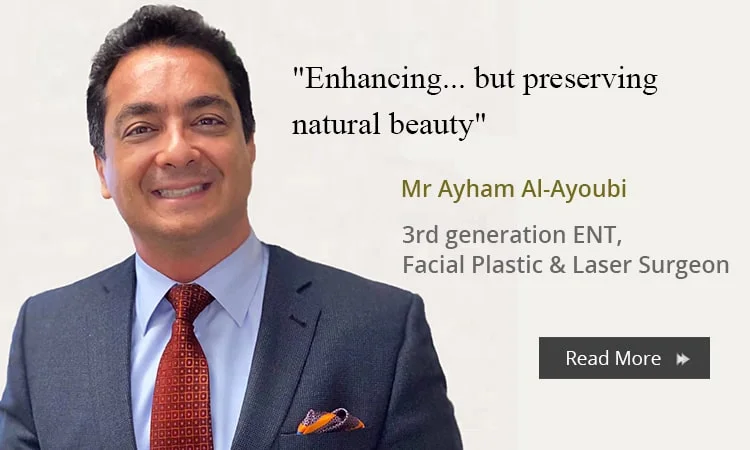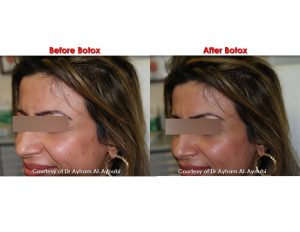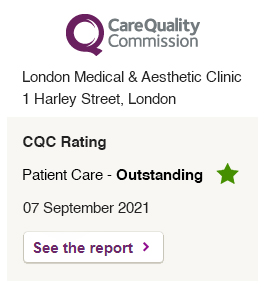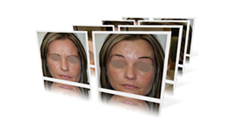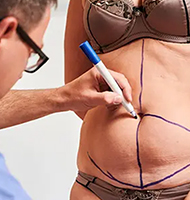We pride ourselves in being one of the leading clinics in anti-wrinkle injections treatment in the UK.
Mr Ayham Al-Ayoubi is a leading facial plastic and laser surgeon and he is an internationally recognised expert in the procedure.
Anti-wrinkle injections are a prescription medicine used to improve the look of moderate to severe dynamic wrinkles and lines on a temporary basis. Not all facial wrinkles benefit from anti-wrinkle injections.
Anti-wrinkle treatments involve the use of injections to smooth facial lines and wrinkles with results lasting 4-8 months.
Anti-Wrinkle Injections Use
The main dynamic facial wrinkles that can be treated with anti-wrinkle treatments are:
- Frown lines (‘glabellar lines’) between the eyebrows
- Crow’s-feet (‘laughter lines’) at the corners of the eyes
- Forehead creases
- The bridge of the nose
Static wrinkles are lines that appear at rest; these do not usually improve with anti-wrinkle treatments and a more effective treatment may be Dermal Fillers or Sculptra – Collagen Stimulation.
Any muscle activity on the body can be targeted with anti-wrinkle treatments, however, it is most commonly performed in the upper face. Whilst it does work around the mouth, chin and neck area, the benefits must always outweigh any possible weakness of the mouth muscles. Smile lines are usually treated using either injectable dermal fillers or CO2 Laser Resurfacing.
In addition to having anti-wrinkle injections for cosmetic purposes, anti-wrinkle injections can be used to treat migraine headaches, hyperhidrosis (excessive sweating), cervical dystonia, cramps, Achalasia, chronic pain and Neuropathy. It is also a possible treatment for some cases of depression.
How Do Anti-Wrinkle Injections Work?
A wrinkle in the skin is typically formed perpendicular to a contracting muscle located directly beneath it. For example, the muscle in the forehead is a vertical muscle, and when it contracts (such as when raising the eyebrows), the lines that form (wrinkles) will be horizontal.
Likewise, the two muscles that are responsible for the frown lines are positioned slightly horizontally between the eyebrows, so when they contract, the frown lines appear vertical.
Anti-wrinkle injections are injected into muscles, where it blocks nerve impulses to those tissues. The muscle activity that causes the frown lines is reduced, and a smoother look results. Without a contracting muscle beneath it, the skin has a difficult time wrinkling.
For muscles to contract, nerves release a chemical messenger, acetylcholine (a neurotransmitter), at the junction where the nerve endings meet muscle cells. Acetylcholine attaches to receptors on the muscle cells and causes the muscle cells to contract or shorten.
Injected Anti-Wrinkle Injections prevents the release of acetylcholine, preventing contraction of the muscle cells. Anti-wrinkle injections cause a reduction in abnormal muscle contraction, allowing the muscles to become less stiff. They are most commonly used to treat forehead lines, laughter lines and frown lines.
Typically, anti-wrinkle injections start to take effect from about the third day after the injections. It may or may not be associated with some very minor tingling, which disappears within a day or so, however, patients must understand that it may take up to ten days for the full effects of the treatment to be seen.
The appearance of frown lines and other treated areas will be dramatically improved within two to ten days of treatment. The skin will appear smoother and unlined. Untreated facial muscles work as usual to allow normal facial expression to be unaffected by the treatment.
It usually takes two to ten days to see cosmetic improvement and the effects tend to last from four to six months. The skin type, skin thickness and degree of wrinkling all play a role in determining how long the results will last. Even if patients are happy with the effects of anti-wrinkle treatment, a top up injection will be required after this period to maintain the skin smoothing effects.
As muscle action gradually returns, the lines and wrinkles begin to re-appear and wrinkles might need to be re-treated. The lines and wrinkles usually appear less severe with time because the muscles are being trained to relax.
Facial lines that exist when the face is totally relaxed are not very good candidates for anti-wrinkle injections. These lines are more effectively reduced or diminished by using dermal fillers. Anti-wrinkle injections can “soften” these lines but not always get rid of them.
Anti-Wrinkle Injections Treatment
The procedure itself is very simple and safe. The facial movements and expressions will be assessed prior to treatment.
Anti-wrinkle injections are administered by diluting the powder in saline and injecting it directly into neuro-muscular tissue. It takes 24-72 hours for Anti-Wrinkle Injections to start to take effect.
No sedation or local anaesthesia is required. Only a topical ice pad should be applied to the skin to decrease the sensation of the injection. The anti-wrinkle treatment is injected with a very tiny needle into specific muscles in the desired areas, causing only minor discomfort.
Depending on the areas treated, between two to six injections are necessary. Once the injection is complete there is usually no discomfort.
Patients might feel slight sensitivity in the area for the next twelve to twenty-four hours, which settles on its own. No down time or recovery is required, and patients can resume normal activities immediately.
Very rarely, some patients experience slight temporary bruising or redness at the injection site. This can be covered with makeup, if necessary.
It is best to avoid alcohol and exposure to excessive sunlight, at least two days prior to treatment. Aspirin should be stopped five days before treatment in order to reduce bruising.
A few simple measures may optimise the safety and improve the results of treatment. To minimise the risk of later bruising, it is recommended that patients discontinue any non-essential medications or dietary supplements that can cause thinning of the blood including:
Aspirin
Non-steroidal anti-inflammatory medications (Ibuprofen, Naproxen)
Fish oil supplements
Vitamin E
Alcohol
Patients should only get anti-wrinkle injections in a clinic by a plastic surgeon or cosmetic doctor. A typical clinical visit usually takes thirty minutes. The patient should have a consultation with the doctor before the treatment to explain the procedure, its benefits, limitations and possible side effects.
Post Treatment Care
Mr Ayham Al-Ayoubi explains that it is advisable not to drink alcohol or exercise within twenty-four hours of the procedure. It is also advisable not to lie down for a few hours after the treatment. Some patients may have slight headaches for a few hours after the treatment. They should take care not to rub or massage the treated areas, as this can cause the toxin to migrate to a different area of the face. If this occurs, temporary facial weakness or drooping is possible.
It is recommended to schedule a follow up appointment in two weeks time, as some patients need a touch up of anti-wrinkle injections to give the best desired results. Most patients have the treatment every six months to help maintain a consistent appearance in the first year. From then on, treatment can be delayed by a few months each time, as wrinkles have become less apparent.
Very deep ingrained lines sometimes require dermal fillers after a couple of weeks; however, this will be advised accordingly.
The Results
Depending on how deep the lines are, anti-wrinkle injections will undoubtedly help and in most instances will smooth the lines away, however, if the lines are very deep, sometimes further treatment with an injectable dermal filler is required in order to get total smoothing of the skin.
The clinical studies indicate that having anti-wrinkle injections over a prolonged period means that over time, one should require fewer injections in the future. The duration of the effect varies from patient to patient and may be less effective for those over 65 years of age.
Before and After photo gallery
Anti-Wrinkle Injections Safety
Anti-wrinkle injections have been used in medicine for almost 50 years. There are approximately 1,800 published studies about it, making it one of the most researched medicines in history.
The FDA approved anti-wrinkle injections treatment as a temporary treatment for moderate to severe frown lines between the eyebrows (glabellar lines), frown wrinkles, forehead wrinkles and eye wrinkles (Crow’s Feet) after formal trials in April 2002.
It is important to understand that whilst anti-wrinkle injections are well tolerated by most people, patients who are pregnant, breast feeding or have neurological or muscle disease should not be treated.
There are very few and rare side effects to the anti-wrinkle injections treatment, such as:
- Temporary, slight bruising that can sometimes occur, however, this can usually be covered with make-up.
- Headaches, which generally improve within twenty-four to forty-eight hours
- Inappropriate facial expression, such as drooping eyelids or drooping brows can occur when injected in this area
- Uneven smile or loss of the ability to close the eyes which wears off in around two- three weeks
Other rare side effects that can occur from anti-wrinkle injections for cosmetic use include headaches, dysphagia, flu-like syndromes, blurred vision, double vision, dry mouth, fatigue, allergic reactions and swelling or redness at the injection site.
Despite precautions, in exceptionally rare circumstances these side effects can still occur, however, due to the non-permanent nature of anti-wrinkle treatment, these are always temporary.
Individuals who are pregnant, breastfeeding or have egg allergies or a neuro-muscular disorder are advised not to have anti-wrinkle injections treatment at all.
The skin type, skin thickness and degree of wrinkling all play a role in determining whether these injections are effective or not.
Around one percent of people receiving anti-wrinkle injections develop antibodies to the toxin that make subsequent treatments ineffective.
Avoiding Anti-Wrinkle Injections Side Effects
All patients who are planning to have anti-wrinkle injection treatments should:
- Ensure that the doctor is very experienced at anti-wrinkle injections and has the necessary accreditation for the treatment
- Inform the doctor about any health problems
- Tell the doctor about any medications they are taking including, vitamins, herbal preparations or other supplements which are being taken, as some combinations of these supplements with anti-wrinkle injections could cause unnecessary side effects.
- It’s especially important to mention having taken injected antibiotics, muscle relaxants, allergy or cold medicines and sleep medicines.
- Follow pre- and post-injection instructions very carefully
- Report any side effects to the doctor and the clinic immediately if they develop
Frequency Of Treatment
Most people see the effects of anti-wrinkle injections for four to six months, but several factors may shorten or lengthen that period:
- Age, older people with less muscle tone may see results diminish sooner than those with younger, firmer facial muscles.
- Facial structure and expressions
- Smoking, as smoking reduces the blood supply to the skin and dehydrates the skin significantly
- Diet
- How well the person takes care of their skin; using facials, microdermabrasion or other resurfacing methods
- Sun exposure and sun damage
- Frequency of having anti-wrinkle injections. However, this seems to differ from one person to another. Some obtain a longer-lasting effect with repeated use, while others seem to develop a resistance to the drug and need more frequent treatment
Anti-Wrinkle Injections for Medical Conditions
Anti-wrinkle injections treatment is the world’s most popular cosmetic procedure. It is also effectively used for:
Migraine Treatment– There are many different types of migraines and the triggers can be different for everyone. Typically, Caucasian females aged 35 -55 years old suffer most frequently. As symptoms arise it’s important to document possible triggers. Recognising patterns can be a useful way to prevent future migraines. In 2010, the FDA approved anti-wrinkle injections for intramuscular injection as a preventative treatment of migraines.
Typically, physicians recommend treatments once every three months. Small doses will be injected in several locations on the face and neck, including on the bridge of the nose, temples, forehead, back of the head, neck and/or upper back.
Inducing muscular paralysis in these key areas has proven effective. The use of anti-wrinkle injections has also relieved many migraine sufferers’ dependence on pain medication. After injection, it can take 10 days to two weeks to experience relief.
Up to 90% of migraine sufferers will have no or markedly reduced attacks for 5-6 months after injections with anti-wrinkle treatments in the trigger points that start the attack.
Excessive Sweating (Hyperhidrosis) – Hyperhidrosis is the medical term for excessive sweating. It refers to any abnormal sweating, such as sweating when it’s not hot. People who sweat excessively often soak through their clothing or drip sweat. Regular antiperspirants don’t work well for those with this condition. In 2004, the FDA approved anti-wrinkle injections for use as a treatment for underarm sweating.
Anti-wrinkle injections can temporarily block the chemical that activates the sweat glands. Treatments are effective almost immediately; however repeat visits are needed every seven to sixteen months.
Overactive Bladders – For people with bladder incontinence, anti-wrinkle injections have proven to be more effective than implanted nerve stimulation devices. Sudden urges to go to the bathroom and frequent leaks keep many people from living their best life. The neurotoxin is injected into the bladder and directly relaxes the overactive muscles.
Issues with incontinence can stem from pregnancy, childbirth, and menopause. During pregnancy, the expanding uterus puts added pressure on the bladder. The bladder sphincter is a valve at the base of the bladder that controls the release of urine into the urethra. The added pressure on the bladder makes it hard to hold urine inside and causes episodes of incontinence.
After childbirth, muscular support in the internal body weakens. The pelvic floor muscles are fatigued and stressed. As well, the process of childbirth can damage the nerves in the bladder. Anti-wrinkle injections help to desensitise an over-active bladder, all with the goal of retraining the bladder to control the urinary output.
History of Anti-Wrinkle Injections
Although the product’s use in the cosmetic world is still in its infancy, anti-wrinkle injections treatment has had a long history that stretches all the way to the 1820s when a German scientist discovered the first strains of the toxin in off sausages, while trying to ascertain how the rotten pork product was making people sick.
Seventy years later, another doctor — also investigating food poisoning — expanded on these findings, discovering seven strains of Anti-Wrinkle Injections, four of which were harmful to humans.
In the 1950s researchers discovered that injecting small amounts of one of the strains (Anti-Wrinkle Injections) into hyperactive muscles relaxed them. Fast-forward to the 80s, the toxin was approved as a treatment for everything from facial spasms and eyelid twitching, to cerebral palsy.
However, the real breakthrough for the injectable as a cosmetic treatment was made in 1987 by two married Canadian doctors, who accidentally discovered the wrinkle-fighting properties of the toxin after noticing that patients who were receiving injections for facial spasms were also losing their frown lines.
Advanced Anti-Wrinkle Injections at Our Clinic
Mr Ayham Al-Ayoubi, an internationally renowned facial plastic and laser surgeon, is one of the very first facial plastic surgeons to use anti-wrinkle injections in the UK in the aesthetic medical field.
Mr Ayham Al-Ayoubi has developed his own advanced techniques in non-surgical facial aesthetic treatments including combining anti-wrinkle injections, Dermal Fillers and Sculptra treatments to treat facial asymmetry, deep acne scars, and traumatic scarring technique which has now been adopted by numerous plastic surgeons and cosmetic doctors worldwide.
Patients travel from all over the UK and from around the world to have Mr Ayham Al-Ayoubi perform his unique advanced techniques in facial aesthetic treatments at our clinic, which is one of the leading training centres for anti-wrinkle injections and Sculptra treatment in the UK and Europe.
Anti-wrinkle injections FAQ’s
The answer to some of the most common questions patients may have about Anti-wrinkle injections procudure.
It’s common for patients to have questions about the aesthetic and laser treatments and at the London Medical and Aesthetic Clinic, it is essential for us that all our patients should feel confident, knowledgable and comfortable at every stage of their journey of their treatments at our clinic.
To help our patients finding the answers they need, here are a few of the most common questions that we find our patients frequently asked:
How long does Anti-wrinkle injections last?
Generally, it should last 4-7 months, each patient is different, nevertheless every patient is very individual and the results could vary from one patient to another.
As the movement of the muscle gradually returns, the lines and wrinkles begin to reappear and need to be treated again. The lines and wrinkles often appear less severe with time because the muscles are relaxed.
What are the possible side effects of Anti-wrinkle injections?
The side effects are very rare and they may include: muscle weakness near where the product was injected, headaches and slight swelling/bruising to the treated area.
Extremely rarer side effects may include: blurred vision, dry mouth, puffy eyelids and tiredness.
What are Anti-wrinkle injections used for?
Anti-wrinkle injections can be used to reduce fine lines and wrinkles by relaxing the underlying muscles. Doctors also use Anti-wrinkle injections to treat excessive sweating, migraines, muscular disorders, and bladder and bowel disorders.
Is the treatment painful?
Some patients find the t Anti-wrinkle injections reatment slightly painful. The injections are most be administered with very fine needles and usually it is painless, nevertheless, some patients do find the treatment slight uncomfortable and very rarely some bruising may occur after treatment.
At our clinic, the Doctor applies ice to the treated area of concern to reduce the chances of pain, swelling and bruising.
Why shouldn’t you drink after Anti-wrinkle injections?
Alcohol and Aspirin should be avoided after treatment as they tend to thin the blood and that will increase the chance of bruising. Therefore, it is advised to not consume alcohol or take certain painkillers as it worsen the bruising after your treatment.
Is Anti-wrinkle injections treatment safe?
The FDA approved anti-wrinkle injections treatment as a temporary treatment for moderate to severe frown lines between the eyebrows (glabellar lines), frown wrinkles, forehead wrinkles and eye wrinkles (Crow’s Feet) after formal clinical trials in April 2002.



